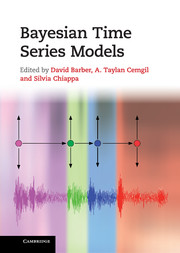Book contents
- Frontmatter
- Contents
- List of contributors
- Preface
- 1 Inference and estimation in probabilistic time series models
- I Monte Carlo
- II Deterministic approximations
- III Switching models
- IV Multi-object models
- 11 Approximate likelihood estimation of static parameters in multi-target models
- 12 Sequential inference for dynamically evolving groups of objects
- 13 Non-commutative harmonic analysis in multi-object tracking
- V Nonparametric models
- VI Agent-based models
- Index
- Plate section
- References
12 - Sequential inference for dynamically evolving groups of objects
from IV - Multi-object models
Published online by Cambridge University Press: 07 September 2011
- Frontmatter
- Contents
- List of contributors
- Preface
- 1 Inference and estimation in probabilistic time series models
- I Monte Carlo
- II Deterministic approximations
- III Switching models
- IV Multi-object models
- 11 Approximate likelihood estimation of static parameters in multi-target models
- 12 Sequential inference for dynamically evolving groups of objects
- 13 Non-commutative harmonic analysis in multi-object tracking
- V Nonparametric models
- VI Agent-based models
- Index
- Plate section
- References
Summary
Introduction
In nature there are many examples of group behaviour arising from the action of individuals without any apparent central coordinator, such as the highly coordinated movements of flocks of birds or schools of fish. These are among the most fascinating phenomena to be found in nature; where the groups seem to turn and manoeuvre as a single unit, changing direction almost instantaneously. Similarly, in man-made activities, there are many cases of group-like behaviour, such as a group of aircraft flying in formation.
There are two principal reasons why it is very helpful to model the behaviour of groups explicitly, as opposed to treating all objects independently as in most multiple target tracking approaches. The first is that the joint tracking of (a priori) dependent objects within a group will lead to greater detection and tracking ability in hostile environments with high noise and low detection probabilities. For example, in the radar target tracking application, if several targets are in a group formation, then some information on the positions and speeds of those targets with missing measurements (due to poor detection probability) can be inferred given those targets that are detected. Similarly, if a newly detected target appears close to an existing group, the target can be initialised using the group velocity.
Information
- Type
- Chapter
- Information
- Bayesian Time Series Models , pp. 245 - 276Publisher: Cambridge University PressPrint publication year: 2011
